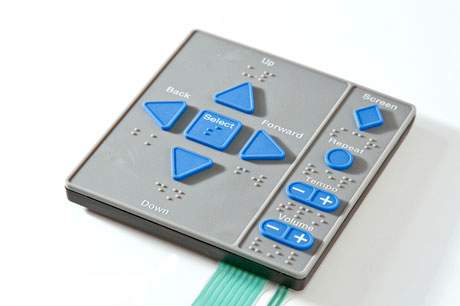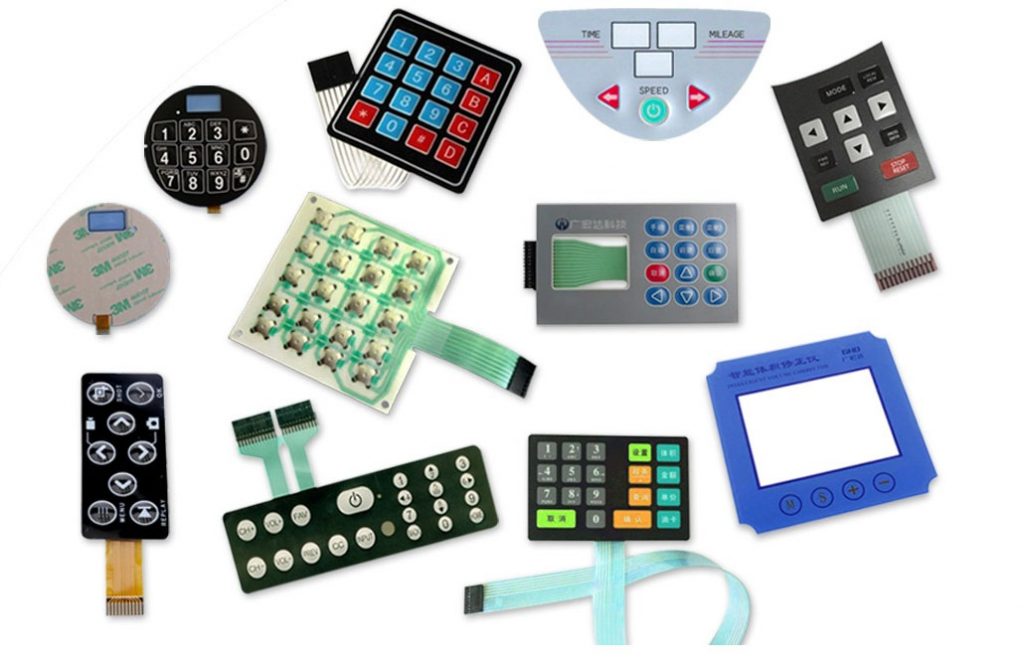Trusted Membrane Switch Manufacturer for Custom Electronic Interfaces
Trusted Membrane Switch Manufacturer for Custom Electronic Interfaces
Blog Article
Understanding the Significance of Membrane Switch in Modern Electronics and Their Applications
Membrane switches offer as an essential element in contemporary electronic devices, using an efficient interface for user interaction. Their personalized and light-weight nature makes them appropriate for a variety of applications across diverse industries. Recognizing their key elements and advantages can provide insights right into their expanding significance. As modern technology proceeds to advancement, the evolution of Membrane switches increases concerns concerning their future applications and style advancements. What lies ahead in this vibrant area?

What Are Membrane Switches?
Membrane switches are vital components in modern-day electronics, offering as interface that help with communication in between devices and customers. These buttons consist of numerous layers, consisting of a visuals overlay, an adhesive layer, and a circuit layer, all of which interact to produce a resilient and functional user interface. The style allows for a level, inconspicuous option that can be tailored relating to size, shape, and visual appearance, making them appropriate for various applications, from consumer electronics to medical devices. The responsive comments supplied by Membrane switches over boosts user experience, while their resistance to dust and moisture makes them perfect for challenging atmospheres. In addition, Membrane switches can include functions such as backlighting and published graphics, even more expanding their usability. Their versatility and toughness make them a favored choice in markets where dependability and simplicity of use are extremely important, ultimately contributing to the smooth operation of contemporary digital devices.
Secret Parts of Membrane Switches Over
While various parts add to the functionality of a membrane layer button, three key layers play significant functions in its layout and procedure. The leading layer, generally made from a durable polymer, offers as the interface for user communication, frequently including published graphics and symbols. Underneath this is the spacer layer, which maintains the required distance between the leading layer and the circuit layer. This spacer layer assurances that the button activates only when pressed, protecting against unexpected inputs. The circuit layer has conductive traces that complete the electrical circuit when the leading layer is depressed. These traces can be made from numerous materials, consisting of copper or silver. With each other, these elements develop a durable and trustworthy tool that is portable and functional, suitable for a vast array of digital applications, from household devices to medical tools. Recognizing these vital parts is crucial for valuing the general functionality of Membrane buttons.
Advantages of Making Use Of Membrane Switches

Membrane Switch Production Process
Comprehending the Membrane switch manufacturing procedure reveals the complex steps included in generating these necessary components. The procedure generally begins with the style phase, where requirements and formats are produced using specialized software. Following this, the graphic overlay is printed on a versatile substrate, commonly making use of high-resolution printing techniques to guarantee quality and precision.Next, the glue layers are used, which serve to bond the different elements together. The circuit layers, made from conductive inks or products, are after that published onto a separate substrate. These layers are meticulously lined up and laminated flooring to create a useful switch.After setting up, the buttons undergo testing to confirm performance and durability. Quality control steps are applied throughout the process to recognize and remedy any flaws. The completed Membrane switches are packaged and prepared for circulation, prepared to meet the needs of modern-day digital applications.
Applications of Membrane Switches in Various Industries
Membrane switches are progressively utilized throughout various sectors, particularly in clinical tools and customer electronic devices. In the clinical field, they give trustworthy control interfaces for tools that need precise operation. In customer electronic devices, these buttons improve customer interaction by offering sleek and responsive interfaces.
Medical Equipment Control
Numerous modern-day clinical tools use Membrane switches for streamlined operation and enhanced user interaction. These buttons supply a trustworthy, long lasting interface for a selection of applications, consisting of analysis tools, client surveillance systems, and medical instruments. Their customizable layouts permit particular formats that can suit the special needs of health care professionals, making certain user-friendly navigating and efficient accessibility to important functions. In addition, Membrane buttons are resistant to contaminants, making them suitable for sterilized atmospheres. The responsive comments they use can enhance individual self-confidence, reducing the risk of errors during vital medical procedures. Overall, the combination of Membrane buttons in medical tools substantially adds to boosted functional performance and person safety and security in health care setups.
Consumer Electronic Devices Interfaces
In the domain of customer electronic devices, Membrane buttons play a vital role in enhancing individual interfaces throughout a large range of gadgets. These buttons are indispensable to items such as remote controls, microwaves, and gaming consoles, providing a user-friendly and effective user interface. Their design permits a smooth integration of graphics and performance, making it possible for producers to produce streamlined, contemporary visual appeals without jeopardizing use. Membrane switches are additionally understood for their sturdiness, frequently withstanding comprehensive use and direct exposure to various ecological problems. In addition, they can incorporate functions like backlighting and responsive comments, more improving the user experience. As consumer needs for advanced yet user-friendly user interfaces grow, Membrane switches remain to be an important component beforehand digital device functionality.
Design Considerations for Membrane Switches
Creating effective Membrane changes requires cautious attention to different factors that affect both functionality and individual experience. One essential factor to consider is the choice of materials, as they can influence durability, tactile comments, and visual appeal. Picking a suitable adhesive is important for guaranteeing long-term adhesion and resistance to advice ecological factors.In addition, the design and layout of the switch need to accommodate individual communication, with switch dimensions and spacing enhanced for simplicity of usage. The incorporation of graphics and labeling must focus on clarity and exposure under numerous lights conditions.Consideration of electrical features, such as actuation pressure and switch sensitivity, will certainly improve the responsiveness of the Membrane button. The layout must fit manufacturing procedures to assure cost-effectiveness and timely production. Overall, a well-balanced layout boosts both the individual and the capability experience of Membrane switches in contemporary electronic devices.

Future Trends in Membrane Switch Modern Technology
As technology remains to evolve, Membrane buttons are poised to incorporate brand-new improvements that will certainly improve their functionality and application in various fields. One considerable fad is the unification of resilient and flexible materials, which will certainly enhance the life-span and reliability of these switches. Improved surface textures and customizable graphics are likewise expected, permitting even more user-friendly individual interfaces.Moreover, the assimilation of clever technology, such as helpful resources touch-sensitive surfaces and haptic feedback, is anticipated to enhance user communication, making Membrane switches over a lot more responsive and interesting. In addition, breakthroughs in printed electronics will certainly allow much more complicated circuitry within thinner profiles, further broadening layout possibilities.Sustainability will additionally play an important function in future growths, as suppliers discover eco-friendly products and manufacturing procedures. In general, these trends will certainly guarantee that Membrane switches over continue to be appropriate and essential in an interconnected and progressively digital world.
Regularly Asked Inquiries
How Do Membrane Switches Contrast to Conventional Mechanical Buttons?
Membrane switches over offer advantages over traditional mechanical buttons, consisting of lowered dimension, lighter weight, and boosted longevity. They commonly offer a sealed surface area, improving resistance to dirt and dampness, making them perfect for diverse applications.
What Materials Are Generally Utilized in Membrane Switch Construction?

Can Membrane Switches Over Withstand Extreme Environmental Conditions?
Membrane switches can hold up against extreme environmental problems, depending upon their design and products. High-grade buildings typically include resilience versus temperature fluctuations, moisture, and direct exposure to chemicals, making them suitable for numerous demanding applications throughout markets.
For How Long Do Membrane Switches Typically Last Before Failure?
Membrane switches commonly exhibit a life expectancy ranging from 1 to 10 million actuations, depending upon factors such as use regularity, environmental conditions, and producing top quality. Routine maintenance can expand their resilience and operational integrity substantially.
Are Membrane Switches Over Personalized for Certain Applications?
Membrane switches are without a doubt personalized for particular applications. They can be tailored in performance, style, and size, enabling makers to satisfy distinct individual needs and improve product appearances while maintaining operational efficiency and longevity. Membrane buttons are vital parts in modern electronics, offering as customer interfaces that facilitate communication between devices and users. The tactile comments given by Membrane switches boosts customer experience, while their resistance to dirt and moisture makes them optimal for testing atmospheres. The consolidation of graphics and labeling must prioritize quality and exposure under numerous lights conditions.Consideration of electric features, such as actuation force and switch sensitivity, will certainly boost the responsiveness of the Membrane button. Enhanced surface area structures and personalized graphics are additionally expected, permitting for more user-friendly individual interfaces.Moreover, the assimilation of smart technology, such as touch-sensitive surfaces and haptic feedback, is expected to enhance individual communication, making Membrane switches a lot more appealing and responsive. Membrane changes offer benefits over conventional straight from the source mechanical switches, including lowered size, lighter weight, and boosted longevity.
Report this page